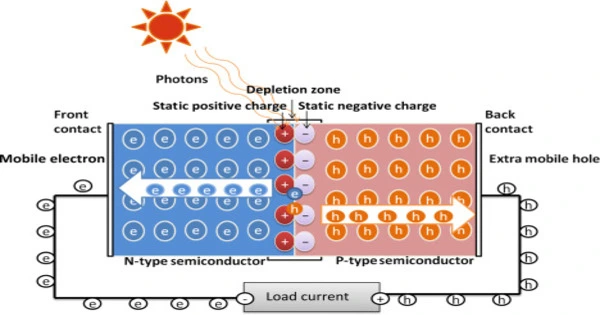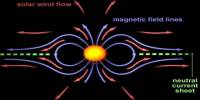The photovoltaic effect occurs when a material generates voltage and electric current when exposed to light. It is both a physical and chemical occurrence. It is caused by the interaction of light particles known as photons with electrons in the material. When high-energy photons collide with the surface of a semiconductor material, they can transfer their energy to electrons, causing them to become excited and move from the valence band to the conduction band, resulting in electron-hole pairs.
The semiconductor material in a typical photovoltaic cell is usually doped with impurities to form a p-n junction. The p-type region has more positively charged holes than the n-type region, which has more negatively charged electrons. When light shines on the cell, photons can penetrate it and generate electron-hole pairs near the p-n junction.
The separated charges, namely electrons in the n-region and holes in the p-region, are pushed in opposite directions by the junction’s built-in electric field, resulting in a voltage across the cell. This voltage difference causes electrons to flow, resulting in an electric current that can be used for a variety of purposes.
The photovoltaic effect and the photoelectric effect are inextricably linked. Light is absorbed in both cases, causing an electron or other charge carrier to be excited to a higher-energy state. The main distinction is that when the electron is ejected out of the material (usually into a vacuum), the term photoelectric effect is used, whereas photovoltaic effect is used when the excited charge carrier is still contained within the material. In either case, the separation of charges produces an electric potential (voltage), and the light must have enough energy to overcome the potential barrier for excitation.
The physical essence of the difference is that photoelectric emission separates charges by ballistic conduction, whereas photovoltaic emission separates charges by diffusion, but some “hot carrier” photovoltaic device concepts blur this distinction.
Various strategies are used to improve the efficiency of photovoltaic cells, such as using multiple layers of semiconductors with different energy bandgaps to capture a wider range of the solar spectrum, incorporating anti-reflective coatings to minimize light reflection, and optimizing material properties and cell design.
The photovoltaic effect has transformed the field of renewable energy by directly converting sunlight into electricity without the use of moving parts or fossil fuels. Solar panels, which are made up of interconnected photovoltaic cells, are widely used in residential, commercial, and utility-scale applications to generate electricity.
















